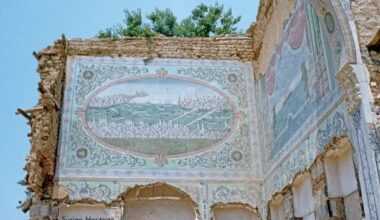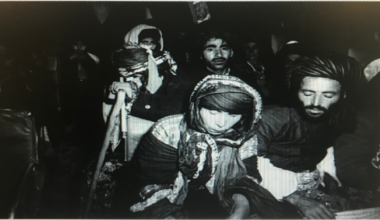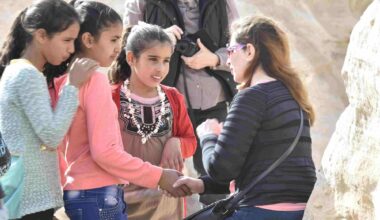By Julio Moreno Cirujano, PhD candidate at SOAS
The Nahalal Police Station is located in the Lower Galilee, just outside the Jewish agricultural settlement of the same name. The fortified structure was built in 1936 but reformed in 1940 as part of Charles Tegart’s security project to quell the Arab revolt and prevent future rebellions. During the 1940s it was commanded by a Jewish sergeant who used it as connecting base for Jewish members of the state police and Hagana intelligence service.

When I visited the building, there was a small museum, and I was shown a video about a mounted policeman from the 1940s. He wore a khaki, folded brim hat, and the uniform of the Jewish Settlement Police (JSP). Around a fire pit he tells us how he immigrated from Europe and enrolled in the Jewish units of the British police force, the Notrim (guards). “The Brits trained us,” he recalls, “they gave us a uniform, a horse, a rifle, and we fought bravely against ‘Arab gangs’.” The video continues exalting the bravery and sacrifices of the Jewish “fighters” and praising British efforts towards the Jewish National Home.

The walls of the museum are covered with pictures of policemen in different uniforms from the 1940s. Among them, visitors can see framed recruitment posters in Hebrew. The first one on the right reads “For the defence of people and homeland: enlist in the Notrim Force”. The Notrim consisted of three specialised forces organised by the British Palestine Police which became closely associated with the protection of Jewish settlements. These posters, printed during WW2, were only one of the multiple areas of collaboration between Zionist institutions and the British administration in Palestine. Thousands of Jewish militants from the Haganah were trained, uniformed, and received a salary from the Government of Palestine from the mid-1930s onwards. In return, the British administration received valuable intelligence on the ground and had an armed reservist militia willing to fight any future Arab uprising.
The police station fell into disrepair, and in the 1990s was earmarked for demolition. But successful pressure from civil society, including the Association of Mandatory Hebrew Policemen and Notrim, overturned this decision and the building was granted heritage status. It was restored and re-opened as part low-security police station and part museum. In other words, the mandatory police station continues to be a police station today and celebrates this period, albeit narrowly focusing on its Jewish members. As the Jewish Settlement policeman tells us during the video: “Together with the British we built the Tegart fortresses against the invaders from the North.” This is not just an overlapping of interests, but a claim for a shared heritage, some sort of continuation.
A very different perspective of the British Mandate is narrated at the Museum of Underground Prisoners, located in the former Central Prison in Acre. The building was originally used as an Ottoman prison and reopened for the same purpose during British rule. It was refurbished as a museum in the 1990s to memorialise the three paramilitary organisations who operated during the Mandate: Haganah, Etzel, and Lehi. Throughout the museum, these organisations are presented as completely detached from the British colonial government. The placards build the narrative of an ingenious secret fellowship that, against all the odds, continued to “fight against the oppressor”; their violent campaigns targeting the government are celebrated. Ironically, the statues of prison guards sprinkled around the museum are uniformed as Notrim, like the ones we see in Nahalal Police Station. It seems that some of these prison officers may have had links with these “underground organisations”.

The substance of the museum is principally to showcase the architecture of the former prison. The cells have been restored and visitors can stroll through the original bar doors. Some tools from the textile workshop, as well as the mattresses used by the prisoners, are exhibited. The wing for Arab inmates has not been restored and it is not visitable. In one room we walk into a scene of a court martial, dimly lit and populated by dark metallic statues. The museum visitor can sit on the benches behind the defendant, whom we assume is a Jewish militant, and face a panel of human-like figures. Only British flags decorate the room, and the darkness of the scene infers the illegitimacy of mandatory justice which took place in the shadows.

We could expect a prison to be turned into a site of resistance. However, the tension between memorialising the self and preserving the other results in reinstatement of British presence through its colonial legacy, if only to construct a partisan narrative and reify the “struggle for independence”. This is best illustrated in the gallows. On the one hand, the memorial on the refurbished wall reclaims the room for a narrow nationalist memory; on the other, the imperfections of the floor when it meets the lever of the executing machinery shows that not everything in the room has been restored. Some defects have been preserved as if the intention was to stop the time when the British administration still governed this prison. Thus, the British legacy is again necessary to explain Israeli heritage.
I found a third reading of the British Mandate in Israel on the walls of a pillbox in Jerusalem. The watchtower in the image is in Rehavia, a residential area in West Jerusalem which developed during the early Mandate and came to be associated with wealthy Jewish immigrants.

As I approached the pillbox, I was struck by the incongruence of using this repressive architecture as a background for a children’s playground. Its hard concrete walls have been softened with colourful and unmistakable images of the British royal guard, who never marched in Palestine. The intention of linking this outpost to the Mandate while appealing to the youth trumps historical accuracy. In fact, when I looked closer, I found a placard which explains that neighbourhood residents had placed this building within a network of local stories which do not intend to be historically accurate. The text continues telling the story of a “lurking monster” who populated Rehavia in the past and how the neighbours were so scared that they had to build a pillbox to protect themselves.
The dissonance between painting the monument as British heritage and, in small print, inaccurately narrating it as a local artefact illustrates the struggle to locate the Israeli past within British colonial heritage. This tension allows for a patchwork of contradictory images for the Israeli self during the mandatory past. What is interesting here is that while the three views presented in the locations above differ on the specific role of the British Mandate, they all chose to restore its repressive architecture and incorporate it into the contemporary Israeli cultural tissue as spaces of leisure.
About the author
Julio Moreno Cirujano is currently writing his PhD dissertation at SOAS University of London on the history of the British Mandate in Palestine. His research focuses on the life of symbolic artefacts as state-building agents, the aesthetics of the nascent nation-state, and the afterlife of colonial material culture. He is the recipient of a CBRL Travel Grant 2021/22.
The views expressed by our authors on the CBRL blog are not necessarily endorsed by CBRL but are commended as contributing to public debate.














